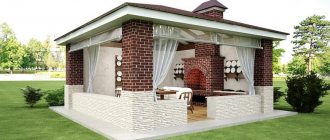Let's start with our gadgets - this will be useful for them. It's no secret that, due to being stuffed with various programs and applications, the battery charge does not last long, and this is especially noticeable when we are away from home. But, most likely, you have already heard about the possibility of making a thermoelectric generator with your own hands, which will serve as a kind of lifesaver for the battery of your smart watch, phone or tablet when you go out into nature.
What is TEG
This device makes it possible to generate electricity from heat energy.
It should be clarified that the expression “Thermal energy” is not entirely correct, since heat is a method of release and is not a separate type of energy. This definition denotes the general kinetics of structural elements:
- molecules;
- atoms;
- other particles that are part of the substance.
Element design
The element consists of two ceramic plates, which serve to insulate two conductors that supply voltage and are secured by thermocouple semiconductors connected in series.
Device diagram
The diagram shows the main elements:
- A - places for connecting to voltage sources;
- B - heated part of the element;
- C - cooled part;
- D - conductors (usually made of copper);
- E - semiconductor element (p-type);
- F - semiconductor element (n-type).
Note! The plate is designed in such a way that its semiconductor parts, due to their type and location, create a temperature difference when passing current. Taken together, this looks like heat transfer from one plate to another.
The difference between TEG and TES
At thermal power plants, fuel is used to release steam from a liquid, which rotates the turbine of an electric generator.
With the help of a thermoelectric generator, electricity is generated without intermediary transformations.
Specifications
The characteristics of thermoelectric modules are described by the following parameters:
- cooling capacity (Qmax), this characteristic is determined based on the maximum permissible current and the temperature difference between the sides of the module, measured in Watts;
- maximum temperature difference between the sides of the element (DTmax), the parameter is given for ideal conditions, the unit of measurement is degrees;
- permissible current required to ensure maximum temperature difference - Imax;
- the maximum voltage Umax required for the current Imax to reach the peak difference DTmax;
- internal resistance of the module – Resistance, indicated in Ohms;
- efficiency coefficient - COP (abbreviation from English - coefficient of performance), essentially this is the efficiency of the device, showing the ratio of cooling to power consumption. For inexpensive elements this parameter is in the range of 0.3-0.35, for more expensive models it approaches 0.5.
Principle of operation
In the nineteenth century, one scientist discovered the emergence of an electromotive force in a closed circuit, when the temperature in the medium contacts antimony with a conductor.
By heating one of the contacts, a magnetic field arises, which causes an EMF. When the second contact is heated, the EMF flux changes in the opposite way.
By breaking the chain, the opposite potentials are fixed at its edges. This is the basic principle of operation of thermoelectric generators.
- Production of explosion-proof equipment
What you need to know when choosing a wind generator
Generator from an asynchronous motor: diagram, table, instructions on how to make it yourself + photo from the master!
Twelve 12 years later, another physicist discovered the opposite effect. By passing current through the thermocouple circuit, temperature differences are created in the contacts.
In principle, these two effects are different sides of the same phenomenon, which makes it possible to directly obtain electricity from heat.
Operating principle of modules
At the contact of dissimilar conductors, heat is released or absorbed depending on the direction of the electric current. The flow of electrons has potential and kinetic energy. The current density in the contacting conductors is the same, but the energy flux densities are different.
If the energy flowing into the contact is greater than the energy flowing out of it, this means that electrons are slowed down at the point of transition from one region to another and heat up the crystal lattice (the electric field slows down their movement). When the direction of the current changes, the reverse process of electron acceleration occurs, when energy is taken from the crystal lattice and its cooling occurs (the directions of the electric field and the movement of electrons coincide).
The energy difference of charges at the boundary of semiconductors is the highest and the effect manifests itself most strongly there.
Peltier module
The most common is the thermoelectric module (TEM), which is p- and n-type semiconductors connected to each other through copper conductors.
Diagram of the operating principle of the module
In one element there are 4 transitions between metal and semiconductors. In a closed circuit, the flow of electrons moves from the negative pole of the battery to the positive, sequentially passing through each transition.
Near the first copper-p-type semiconductor transition, heat is released in the semiconductor zone as electrons move to a state with lower energy.
Near the next boundary with the metal in the semiconductor, heat is absorbed due to the “sucking out” of electrons from the p-conductivity zone under the influence of an electric field.
In the third transition, electrons enter the n-type semiconductor, where they have higher energy than in the metal. In this case, energy is absorbed and the semiconductor is cooled near the transition boundary.
The last transition is accompanied by a reverse process of heat release in the n-semiconductor due to the transition of electrons to a zone with lower energy.
Since the heating and cooling transitions are in different planes, the Peltier element will be cooled from above and heated from below.
In practice, each element contains a large number of heating and cooling transitions, which leads to the formation of a noticeable temperature difference, which makes it possible to create a thermoelectric generator.
What does the module structure look like?
The Peltier element contains a large number of semiconductor parallelepipeds of p- and n-types, connected in series with metal jumpers - thermal contacts, the other side in contact with the ceramic plate.
Bismuth telluride and silicon germanide are used as semiconductors.
Advantages and disadvantages of TEM
The advantages of a thermoelectric module (TEM) include:
- small sizes;
- the ability to operate both coolers and heaters;
- reversibility of the process when changing polarity, allowing you to maintain an exact temperature value;
- absence of moving elements that usually wear out.
Disadvantages of modules:
- low efficiency (2-3%);
- the need to create a source that provides a temperature difference;
- significant energy consumption;
- high price.
Despite the disadvantages, TEMs are used where high energy costs are not important:
- cooling of chips, parts of digital cameras, diode lasers, quartz oscillators, infrared detectors;
- the use of TEM cascades to achieve low temperatures;
- creation of compact refrigerators, for example, for cars;
- thermoelectric generator for charging mobile devices.
Prospects
At this time, they continue to carry out experiments, selecting the optimal thermocouples to increase the efficiency.
There is a high probability that soon the development of improving the quality of thermal elements will acquire the highest status in the production of material to increase the interaction of thermocouples, using high technologies:
- nanotechnology;
- quantization pits, etc.
It is quite possible to invent a completely different principle, using non-standard materials.
Do-it-yourself solar battery - step-by-step instructions on how to make and install a solar battery at home (photo and video instructions)How to choose a solar power plant: ready-made solutions, operating principle, how to choose and install it yourself (photo + video instructions)
Solar collectors for home heating: advantages, disadvantages, myths, truth and reviews from owners (130 photos + video)
There have been attempts to connect microscopic gold conductors with an artificially synthesized molecule. This experience may well lead to success in the future.
How to check for functionality
When purchasing and using, the question may arise of how to check the functionality of the Peltier element. The easiest way to check is to connect the thermocouple to a voltage source and test both sides by hand. One side should be cold, and the other should start to heat up.
If it is not possible to use a current source from which the element could be powered, then you will have to go from the opposite. To do this, you need to have a multimeter and a fire source (preferably a lighter) on hand. The multimeter leads must be connected to the wires from the element. After this, you need to run a lighter along one of the sides.
Note! If the plate is working, then under the influence of fire it will begin to generate a certain amount of electricity. This can be seen from the readings of the electrical measuring device.
The Peltier element can be used in many areas of activity of an ordinary person. Making a high-quality and effective element yourself at home is quite difficult. It’s easier to buy a ready-made one in a store and use it to build many useful structures at home.
How to make it yourself
Next, we will briefly tell you how to make a generator with your own hands, which can be used in natural conditions or in de-energized places.
Of course, the power of these devices cannot be compared with a radioisotope specimen, but due to the difficult availability of plutonium and its harmful qualities for the human body, one has to rejoice at this.
A thermoelectric element will be required. It is better to use them not in a single copy, connecting them in parallel, this will increase the power.
However, there is a big problem: it is necessary to select elements with similar parameters, which is quite difficult or expensive; it is easier to purchase a ready-made device.
Wind power plants for home - pros, cons and review of the best modern models (105 photos)Do-it-yourself biogas plant - step-by-step description of production, 130 photos and video description of the biogas plant
- How to find builders for office renovations
Using one element, the power may not be enough to charge even the simplest gadget.
You will also need a metal case, for example, a used and no longer needed power supply from a personal computer, and a processor cooling element.
Calculation method for a homemade refrigerator using Peltier elements
We proceed from the fact that heat loss depends linearly on the temperature difference inside and outside a homemade refrigerator. Let's go from simple to complex:
- Let’s say the temperature in the room is 20 ºС and remains unchanged throughout the experiment. Let's start the research. Obviously, in the absence of Peltier elements, the temperature inside the refrigerator will be 20 ºС. This is the first point on the straight line (losses increase linearly from the temperature difference between the outside and inside of a homemade refrigerator). We will install a Peltier element with radiators on both sides, and the outer one will be blown by a cooler to enhance the effect.
- After a while, the temperature in the 30-liter compartment was 14 ºС. We claim that by adding two more Peltier elements with radiators and coolers, anyone will receive 2 degrees of heat inside a homemade refrigerator if the room is 20 ºC warm. Scheme:
- Draw two axes on a piece of paper. At the point of intersection of both is zero. Horizontal – temperature line.
- Mark a point of 20 ºС on the horizontal. This is the initial moment when zero power is wasted, and the temperature inside the homemade refrigerator is equal to room temperature.
- Now draw a straight line from the drawn point, intersecting the vertical axis at any, but always positive, height.
- Mark a point on the X-axis (temperatures) two-thirds from the origin. This is 14 ºС, and vertically on the line is the power of one Peltier element that balanced the losses.
- Now mark a point one third from the beginning. Here it is 8 ºС, and you will need two Peltier elements. This can be seen from the graph.
The main nuances of the assembly
Initially, you need to apply thermal paste to the base where the main element is intended to be fixed, lean it against it and press it with a cooling part.
The result is a constructive product. Dry alcohol will probably be the best fuel for this device. Next, you need to connect a voltage stabilizing device to the made device.
The diagram can be viewed on websites on the Internet or in other sources offering this topic.
The product is ready, now all that remains is to test it.
Where is it used?
The miniaturization of these elements and their relatively low energy consumption - coupled with the absence of moving parts or various liquids used for heat transfer - provides a wide range of niches of use. This includes car air conditioners, cooling systems for microcircuits and electronic elements, mini-refrigerators, stands that maintain a certain temperature of containers placed on top. In addition to the above, equipment based on Peltier elements is used in specific areas, such as PCR amplifiers, heated camera flash systems, telescopes (to reduce thermal noise) and radiation receivers of infrared devices.
Less often you can see the real element as part of the design of generators. Although devices of a similar class periodically appear on the markets, for example, in the form of flashlights powered by the heat of the human body or weak machines that produce electric current to recharge the batteries of smartphones or laptops.
Voltage obtained at the output of Peltier elements:
Photo of a thermoelectric generator with your own hands
Did you like the article? Share

1+
Application
Despite the rather low efficiency, thermoelectric elements are widely used in measuring, computing, and household appliances. Modules are an important operating element of the following devices:
- mobile refrigeration units;
- small generators to generate electricity;
- cooling systems in personal computers;
- coolers for cooling and heating water;
- dehumidifiers, etc.
Let us give detailed examples of the use of thermoelectric modules.
Refrigerator using Peltier elements
Thermoelectric refrigeration units are significantly inferior in performance to compressor and absorption analogues. But they have significant advantages, which makes their use advisable under certain conditions. These advantages include:
- simplicity of design;
- vibration resistance;
- absence of moving elements (except for the fan blowing the radiator);
- low noise level;
- small dimensions;
- ability to work in any position;
- long service life;
- low energy consumption.
These characteristics are ideal for mobile installations.
Thermoelectric auto-refrigerator installed in the car interior
Peltier element as an electricity generator
Thermoelectric modules can work as electricity generators if one of their sides is subjected to forced heating. The greater the temperature difference between the sides, the higher the current generated by the source. Unfortunately, the maximum temperature for the thermal generator is limited; it cannot be higher than the melting point of the solder used in the module. Violation of this condition will lead to failure of the element.
For mass production of thermal generators, special modules with refractory solder are used; they can be heated to a temperature of 300°C. In ordinary elements, for example, TEC1 12715, the limit is 150 degrees.
Since the efficiency of such devices is low, they are used only in cases where it is not possible to use a more efficient source of electrical energy. However, 5-10 W thermal generators are in demand among tourists, geologists and residents of remote areas. Large and powerful stationary installations powered by high-temperature fuel are used to power gas distribution units, meteorological station equipment, etc.
Thermoelectric generator B25-12 (M) 12 volt, 25 watt
To cool the processor
Relatively recently, these modules began to be used in CPU cooling systems of personal computers. Considering the low efficiency of thermoelements, the benefits of such structures are rather doubtful. For example, to cool a heat source with a power of 100-170 W (corresponding to most modern CPU models), you will need to spend 400-680 W, which requires installing a powerful power supply.
The second pitfall is that an unloaded processor will release less thermal energy, and the module can cool it below the dew point. As a result, condensation will begin to form, which is guaranteed to damage the electronics.
Those who decide to create such a system on their own will need to carry out a series of calculations to select the power of the module for a specific processor model.
Based on the above, using these modules as a CPU cooling system is not cost-effective; in addition, they can cause computer equipment to fail.
The situation is completely different with hybrid devices, where thermal modules are used in conjunction with water or air cooling.
Thermoelectric cooler Armada
Hybrid cooling systems have proven their effectiveness, but the high cost limits the circle of their admirers.
Air conditioner based on Peltier elements
Theoretically, such a device will be structurally much simpler than classic climate control systems, but it all comes down to low performance. It’s one thing to cool a small volume of a refrigerator, another thing to cool a room or the interior of a car. Air conditioners using thermoelectric modules will consume more electricity (3-4 times) than equipment running on refrigerant.
As for using it as a car climate control system, the power of a standard generator will not be enough to operate such a device. Replacing it with more efficient equipment will lead to significant fuel consumption, which is not cost-effective.
In thematic forums, discussions on this topic periodically arise and various home-made designs are considered, but a full-fledged working prototype has not yet been created (not counting the air conditioner for a hamster). It is quite possible that the situation will change when modules with more acceptable efficiency become widely available.
For cooling water
The thermoelectric element is often used as a coolant for water coolers. The design includes: a cooling module, a thermostat-controlled controller and a heater. This implementation is much simpler and cheaper than a compressor circuit; in addition, it is more reliable and easier to operate. But there are also certain disadvantages:
- water does not cool below 10-12°C;
- cooling takes longer than its compressor counterpart, therefore, such a cooler is not suitable for an office with a large number of employees;
- the device is sensitive to external temperature, in a warm room the water will not cool to the minimum temperature;
- Installation in dusty rooms is not recommended, as the fan may become clogged and the cooling module may fail.
Tabletop water cooler using Peltier element
Air dryer based on Peltier elements
Unlike an air conditioner, the implementation of a dehumidifier using thermoelectric elements is quite possible. The design is quite simple and inexpensive. The cooling module lowers the temperature of the radiator below the dew point, as a result, moisture contained in the air passing through the device settles on it. The settled water is discharged into a special storage tank.
A simple and inexpensive Chinese dehumidifier using Peltier elements
Despite the low efficiency, in this case the efficiency of the device is quite satisfactory.
Electricity from two rods
This method is based on a completely different theory and has nothing to do with the Earth’s magnetic or electric field. And this theory is about the interaction of galvanic pairs in a saline solution. If you take two rods of different metals and immerse them in such a solution (electrolyte), a potential difference will appear at the ends. Its value depends on many factors: composition, saturation and temperature of the electrolyte, size of the electrodes, immersion depth, and so on.
Such generation of electricity is also possible through the ground. We take 2 rods from different metals, forming a so-called galvanic pair: aluminum and copper. We immerse them in the ground to a depth of approximately half a meter, keeping the distance between the electrodes small, 20-30 cm is enough. We water the area of land between them generously with saline solution and after 5-10 minutes we take measurements with an electronic voltmeter. The meter readings may vary, but at best you will get 3V.
Note. The voltmeter readings depend on the soil moisture, its natural salt content, the size of the rods and the depth of their immersion.
In fact, everything is simple, the resulting free electricity is the result of the interaction of a galvanic couple, in which moist earth served as an electrolyte, the principle is similar to the operation of a salt battery. A real experiment on the potential difference across electrodes driven into the ground can be viewed at:
Refrigerator made of polystyrene foam and Peltier modules
Today’s article is not about turning packaging foam into glue by dissolving it in acetone. Today we’ll talk about a homemade product that’s a little more complex, but very useful in the household, garage or home. Since our school days, we have known about the Peltier element, which, when some voltage is applied to it, releases heat on one side and cold on the other.
The same element, 75 Watt. So, we will make a mini refrigerator, you can call it a tabletop one. And, to begin with, let's take thin packaging foam and use double-sided tape to assemble a box with a door from it. We take the size of the box approximately as a 5 liter water bottle.
A box made of polystyrene foam. Next, we assemble the main part. We glue a small aluminum radiator from electronics to the cold side of the element using thermal paste. On the hot side we glue a processor radiator with a fan onto the same compound.
The main unit of the device. Having cut a hole in the back wall of the box, insert a cold radiator inside and glue the entire unit to the back wall.
Rear wall of the refrigerator. Connect the ends of the element and the fan in parallel, supply 12 Volts. We put a couple of cans of foam in our refrigerator. After an hour, drink the drink at a temperature of 15 degrees.
The result of efforts. Source










